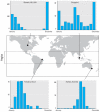Global influenza seasonality: reconciling patterns across temperate and tropical regions
- PMID: 21097384
- PMCID: PMC3080923
- DOI: 10.1289/ehp.1002383
Global influenza seasonality: reconciling patterns across temperate and tropical regions
Abstract
Background: Despite the significant disease burden of the influenza virus in humans, our understanding of the basis for its pronounced seasonality remains incomplete. Past observations that influenza epidemics occur in the winter across temperate climates, combined with insufficient knowledge about the epidemiology of influenza in the tropics, led to the perception that cool and dry conditions were a necessary, and possibly sufficient, driver of influenza epidemics. Recent reports of substantial levels of influenza virus activity and well-defined seasonality in tropical regions, where warm and humid conditions often persist year-round, have rendered previous hypotheses insufficient for explaining global patterns of influenza.
Objective: In this review, we examined the scientific evidence for the seasonal mechanisms that potentially explain the complex seasonal patterns of influenza disease activity observed globally.
Methods: In this review we assessed the strength of a range of hypotheses that attempt to explain observations of influenza seasonality across different latitudes and how they relate to each other. We reviewed studies describing population-scale observations, mathematical models, and ecological, laboratory, and clinical experiments pertaining to influenza seasonality. The literature review includes studies that directly mention the topic of influenza seasonality, as well as other topics we believed to be relevant. We also developed an analytical framework that highlights the complex interactions among environmental stimuli, mediating mechanisms, and the seasonal timing of influenza epidemics and identify critical areas for further research.
Conclusions: The central questions in influenza seasonality remain unresolved. Future research is particularly needed in tropical localities, where our understanding of seasonality remains poor, and will require a combination of experimental and observational studies. Further understanding of the environmental factors that drive influenza circulation also may be useful to predict how dynamics will be affected at regional levels by global climate change.
Figures


References
-
- Abu-Amer Y, Bar-Shavit Z. Impaired bone marrow-derived macrophage differentiation in vitamin D deficiency. Cell Immunol. 1993;151:356–368. - PubMed
-
- Alonso WJ, Viboud C, Simonsen L, Hirano EW, Daufenbach LZ, Miller MA. Seasonality of influenza in Brazil: a traveling wave from the Amazon to the subtropics. Am J Epidemiol. 2007;165:1434–1442. - PubMed
Publication types
MeSH terms
LinkOut - more resources
Full Text Sources
Medical
Miscellaneous
